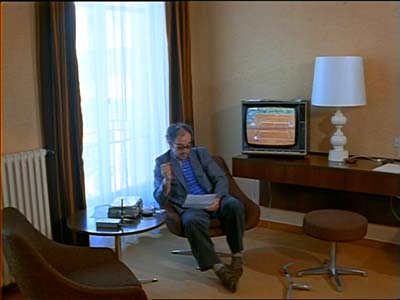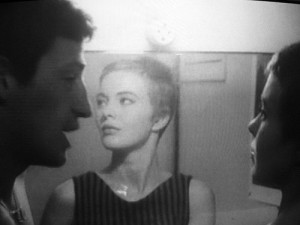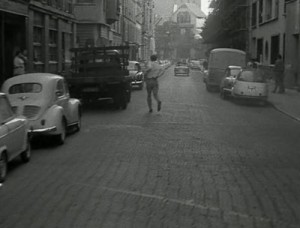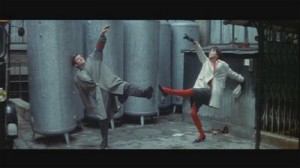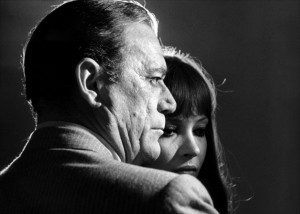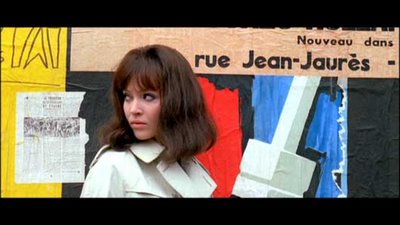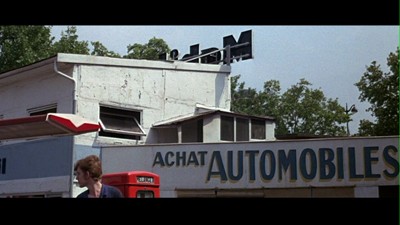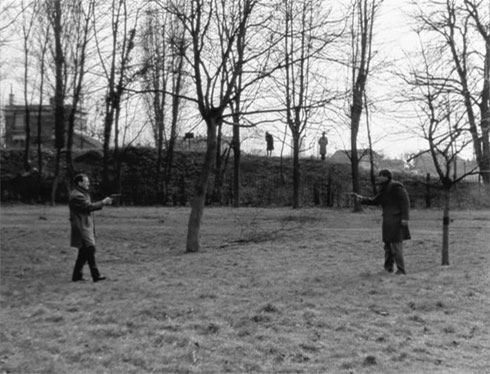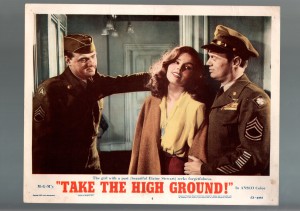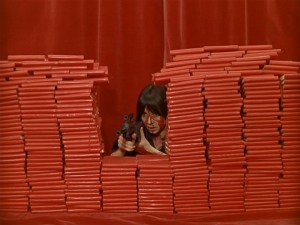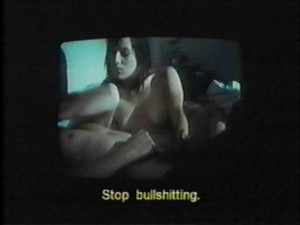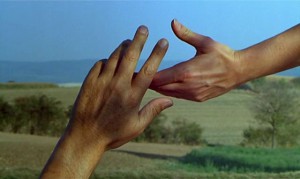From Jean-Luc Godard: Son-Image 1974-1991 (New York: Museum of Modern Art, 1992). -– J.R.
“Jean-Luc cultists,” complains Judith Crist in the World Journal Tribune. God bless them! They constitute a line of defense against every manipulative insult the entertainment business throws out, there are more of them each year, and they may even be winning. — Roger Greenspun (1)
Greenspun’s rallying cry of a quarter of a century ago testifies to the passion and debate that used to be stirred up in the United States when Godard’s name was mentioned. The gradual phasing out of that debate and the depletion of that passion cannot be explained simply, and to understand it at all requires some careful thought about how American culture as a whole has itself changed in the interim. For a director still closely identified with the sixties in American film criticism, Godard is regarded today with much of the same fear, skepticism, suspicion, and impatience that greet many other contemporary responses to that decade. And his status as an intellectual with a taste for abstraction may make him seem even more out of place in a mass culture that currently has little truck with movie experiences that can’t be reduced to sound bites. (One might add that he has still fared somewhat better in this respect than Antonioni, whose American reputation has suffered an almost total eclipse.)
Roughly speaking, Godard’s career as a critic spans sixteen years, from an auteurist appreciation of Joseph Mankiewicz, published in the second issue of Gazette du Cinéma in 1950, to “3000 heures de cinéma,” published in the 184th issue of Cahiers du Cinéma (November 1966). His career as a director of features has lasted almost twice as long and reveals a comparable ambivalence toward the U.S., with both a love of William Faulkner and Robert Aldrich and a mockery of American power and influence extending all the way from Breathless to Nouvelle Vague. But in contrast to this sustained love-hatred that, through all its vicissitudes, has never ceased to be both pursuit and flight, embrace and recoil, the relationship of the U.S. to Godard has, broadly speaking, been one of increasing fascination (roughly 1961 to 1973), followed by decreasing interest (roughly 1974 to 1992).
It should be recalled, however, that, even at the height of his popularity as an arthouse director, Godard was always something of a minority taste among critics and audiences alike. While the American critics and institutions that were originally most supportive of his work — Richard Roud, Susan Sontag, Andrew Sarris, Pauline Kael, and Vincent Canby, among the former; the New York Film Festival, The Museum of Modern Art, and New Yorker Films, among the latter — have been highly influential, mainstream resistance to Godard’s work has remained constant over the past three decades, becoming increasingly decisive over the second half of this period.
The remarks that follow will attempt to pinpoint some of the sources of that resistance. Without pretending in any way to be exhaustive, I think that the principal obstacles to the American appreciation of Godard that have existed — and, in many cases, continue to exist — point toward a complex of cultural attitudes that ultimately have bearing on much more than Godard’s work. Nevertheless, insofar as Godard’s name has remained both a symbol and a rallying point for a certain kind of cinema since the beginning of his career, it seems useful to delve here, however incompletely, into the question of what that kind of cinema has meant, and continues to mean, in an American context.
While much of my emphasis will be on the American reception of Godard’s work since 1974, it is important to bear in mind that Godard’s American reputation prior to this period, beginning in 1961 with the release in the United States of his first feature, Breathless, affected his subsequent reputation in two largely antithetical ways. That is, part of the resistance to Godard in this country since I974 can be construed as a backlash to the former centrality of Godard’s name and work in certain circles, while another part of that resistance is due to a lack of awareness of his former centrality, especially among younger viewers. (Two significant instances of this latter situation, both dating from the early eighties, are worth citing here. By his own account, Jim McBride was able to finance his American remake of Breathless only because most producers he approached had heard of the film but had never seen it; and when Godard’s Passion received an uncharacteristically wide American release a year or so later, it was most often billed — in ads, on marquees, and even in recorded phone messages at theaters – as “Francis Coppola’s Passion”.)
Although many of the topics addressed below represent ongoing problems of reception rather than obstacles posed in a particular period, and some of these are overlapping rather than sequential, I have given these topics in a very rough chronological order, from problems associated with Godard during the sixties, to the recent present.
1. Tbe Nouvelle Vague context. Clearly, the fact that Breathless was originally perceived as part of a larger artistic movement helped immeasurably in providing Godard’s first American audiences with a loose context in which to understand his work. Breathless opened in New York the same year as Claude Chabrol’s The Cousins, after Alain Resnais’ Hiroshima, Mon Amour, Francois Truffaut’s The 400 Blows, and Louis Malle’s The Lovers already appeared, and while information about “the Nouvelle Vague” in the American press tended to be somewhat vague and confused — characteristically, both Resnais and Malle were often assumed to be Cahiers du Cinéma critics along with Truffaut, Godard, and Chabrol — the sense of Godard being part of a larger movement was already fairly pronounced.
White the Nouvelle Vague continued to be regarded as a viable journalistic hook by American critics throughout most of the sixties, subdivisions and discriminations became more apparent as more films and information became available. It was eventually understood that directors who had started out as critics on Cahiers du Cinéma — Godard, Truffaut, Chabrol, Jacques Rivette, and Eric Rohmer — represented a particular core group in the Nouvelle Vague, identifiable by their eccentric taste for American genre films, their low-budget methods of shooting, and their relatively freewheeling styles. (Regarding the latter, it was widely believed that most or all of these directors depended a great deal on improvisation. The appearance of John Cassavetes’ Shadows around the same time as Breathless led some reviewers to make certain connections between the two, without discriminating between the actor’s [alleged] improvisations in Shadows and Godard’s practice on Breathless of working without a complete shooting script; some time passed before it was understood that Jean-Pau[ Belmondo’s asides and rambling monologues at the beginning of Breathless weren’t the actor’s own inventions.) Many other popular French films of this period, such as Marcel Camus’s Black Orpheus, Resnais’ Last Year at Marienbad, Malle’s Zazie, and the early films of Jacques Demy and Philippe de Broca, were often labeled “Nouvelle Vague” as well, and it was a while before the efforts of the better-informed critics made it apparent that some of these films, like those of Resnais and Demy, were more related to the tastes and methods of the core group than certain others, like those of Camus and de Broca.
The eventual dissolution of the original concept of “Nouvelle Vague” — with reference both to the core group and to its wider applications — was gradual, and largely came about when the ideological, temperamental, and stylistic differences between members of the core group became too glaring to overlook. Godard’s increasing move toward Leftist politics articulated one of the most striking of these differences (see #5, below), and if one draws certain approximate parallels between the dissolution of the Cahiers core group and the breakup of the Beatles (which occurred during the following decade), it is clear that Godard was the John Lennon of the group. (Following the same rough parallel, Truffaut was the Paul McCartney and Rivette was the George Harrison, although one clearly couldn’t postulate either Chabrol or Rohmer as an equivalent to Ringo Starr.) By the time that “Nouvelle Vague” became appropriated as “New Wave” to refer to a kind of rock music, the original meaning of the term had passed out of the working vocabulary of the American mainstream — so much so that contemporary American academics who teach Nouvelle Vague films generally feel obliged to speak of the “French New Wave” in order to avoid confusion.
One final comment regarding the original Cahiers core group is worth stressing. As many of the eccentric film tastes of these critic-directors gradually passed into the American mainstream — so that it eventually became less shocking to regard Alfred Hitchcock and Howard Hawks as serious and important directors –_the polemical force of Cahiers du Cinéma’s position regarding American cinema was largely dissipated, thanks in large measure to the early critical efforts of Andrew Sarris, terms like “auteur” and “mise en scène” (the latter with hyphens added) entered the language, and the notion of treating popular American mainstream and genre directors as serious artists became not only acceptable but firmly entrenched, eventually lent even more credence by the expanded role played by promotion (and the promotion of certain directors) in the reception of big-studio Hollywood features. Broadly speaking, the attention once accorded to figures like Godard and Truffaut (and other foreign directors like Bergman and Fellini) as “artists” is lavished today on directors such as Martin Scorsese and Woody Allen. Meanwhile, current American interest in Cahiers du Cinéma is so slight that a respected writer for the New York Times could recently state that the magazine “is no longer fascinated by Hollywood” — a remark nearly fifteen years out of date. (2)
2. Release patterns. According to the filmography in Richard Roud’s Godard (3), the first book about Godard in English, Godard’s early features opened commercially in the United States in the following order and years: Breathless (1961), Vivre sa vie (1963), Contempt (1964), A Woman is a Woman (1964), The Married Woman (1965), Alphaville (1965), Band of Outsiders (1966), Masculine Feminine (1966), La Chinoise (1968), Les Carabiniers (1968), Weekend (1968). During the same period, his other early features made their first U.S. appearances at the New York Film Festival: Le Petit Soldat (1965), Pierrot le fou (1966), Made in U.S.A. (1967), 2 or 3 Things I Know About Her (1968), Le Gai Savoir (1969); the rarely shown May 1968 documentary Un Film comme les autres had its first screening in the United States on the premises shared by the New York Film Festival, Philharmonic Hall, early in 1969.
Putting these lists together and noting specific dates, one can say that Godard’s first features appeared in the U.S. in the following sequence: 1, 4, 6, 3, 8, 2, 9, 7, 10, 11, 12, 5, 14, 13, 15, 17, 16. This almost continuous disruption of what might be regarded as the logical development of Godard’s work from one feature to the next was bound to lead to certain confusions. (In France, by contrast, the sequence was broken only by the initial banning of Le Petit Soldat, Godard’s second feature, which opened in Paris the year after Vivre sa vie, his fourth.) Haphazard programming patterns also tended to obscure certain linkages that enhanced and clarified many of the films in question; for example, Made in U.S.A. and 2 or 3 Things I Know About Her, made concurrently in 1965, premiered at the New York FiIm Festival a year apart, in 1967 and 1968, respectively. The latter film was eventually released in 1970; the former, due to legal problems involving the Richard Stark novel that was the film’s putative source, has never been released in the United States at all.
3. The price of innovation. As far back as the mid-sixties, it was already a commonplace that many of Godard’s most “innovative” practices — such as his jump cuts, employment of direct sound and interview formats, fractured story lines, references to other films, freewheeling uses of pop culture, and essayistic digressions — were no longer as startling as they had initially been, because of their widespread influence on other filmmakers. But even though a considerable residue from his eclectic strategies was finding its way into other films, including those of the mainstream, Godard had the talent to remain ahead of his imitators by continuing to develop in unforeseeable ways — a talent significantly shared, and always to his commercial detriment, by Orson Welles.
Unlike such relatively “bankable” European filmmakers as Bergman and Fellini, Godard could never be trusted either by producers or by spectators to “deliver the goods,” in the sense of repeating the formula (or at least the surface appearance) of a previous success –- the means by which most well-known contemporary American directors make themselves known. As recognizable as Godard’s style may be to aficionados, it has never adopted such obvious signatures as the white-on-black credits of Woody Allen films or “Spielberg lighting”. Today, when the dominance of advertising has had an increasing effect on criticism, any film or filmmaker that can’t be marketed as an immediately identifiable quantity runs the risk of disappearing quickly from sight.
4. Aesthetic conservatism. Perhaps the most thoroughgoing American attack on Godard’s work published to date is John Simon’s essay “Godard and the Godardians: A Study in the New Sensibility.” (4) In the second paragraph of this lengthy broadside, Godard is linked by Simon to currents in the other arts that Simon equally disapproves of, including “aleatory and electronic music,” “action painting, Pop and Op art, junk sculpture,” “rock ‘n’ roll and its sundry derivatives in popular music,” and “happenings, events, environments, and other ‘mixed media.’ “ Significantly, the only area of film that Simon chooses to relate Godard to in this paragraph is neither “the New Wave” nor any other European film currents, but “‘underground movies’ or ‘New American Cinema,”‘ a movement whose most vocal figures during this period were not among Godard’s strongest defenders. (While Jonas Mekas and a few other writers in Film Culture praised some of the early features, it was generally felt in American avant-garde film circles that Godard’s reliance on narrative and on professional actors disqualified him from serious consideration. Significantly, the only “Nouvelle Vague” figure recognized in the permanent collection of the Anthology Film Archives was — and still is — Marcel Hanoun. Mekas wrote in 1970, “With Pravda Godard finally abandons commercial cinema and joins the underground.” Mekas declared Pravda Godard’s best film to date, but this review proved to be an isolated case.)
The bulk of Simon’s essay is devoted to point-by-point refutations of Godard’s leading American supporters at the time – Sontag, KaeI, Sarris, and Roud — along with John Russell Taylor and A. Alvarez in England. His principal charge throughout is that Godard is an undisciplined, unstructured filmmaker for whom “anything goes,” and it is worth adding that in spite of Simon’s many objections to the claims of Godard’s defenders, there are some points of agreement about where to situate Godard in relation to currents in the other arts. Indeed, Sontag’s evocations of a “new sensibility” in Against Interpretation (5) — which also contains a philosophical analysis of Vivre sa vie attacked by Simon — and her passionate and extended appreciation of Godard in Styles of Radical Will (6) allude to most of the same artistic currents as Simon does, although for her these connections are positive rather than negative factors. On the other hand, faced with Sarris’s positioning of Godard alongside “Stravinsky, Picasso, Joyce, and Eliot,” Simon argues, “About the only place where Godard’s position might be comparable to that of the other four is on the toilet seat. But Godard, alas, also expels his work from that position.”
Rereading Simon’s hysterical diatribe today, one is struck by how much of his anger is directed at Godard’s respectful (if eclectic) attitude toward popular culture, Hollywood movies in particular. His opening and pivotal example from Godard’s work that elicits his deepest scorn is the offscreen recitation of Apollinaire’s poem “Cors de chasse” during the screening of a Western. “What business,” asks Simon, “have the characters in a vulgar American western reciting one of France’s finest 20th-century lyrics at each other — and antiphonally at that, as though it were dialogue that they were improvising?” (Later in the same essay, Simon is equally dismayed by Kael’s respectful attitude toward American gangster movies, in her review of Band of Outsiders.) In short, the major issue at stake for Simon was literary high culture versus the encroachments of popular culture, and he regarded Godard (rightly, I think) as a major force in making such encroachments acceptable. (A specialist in theater and European literature, Simon exemplified a certain literary bias in relation to film that was considerably more prevalent among intellectual circles prior to the beginnings of film studies as an academic discipline during the seventies.)
5. Political conservatism. A love-hatred relationship with America has been apparent in Godard’s work ever since Breathless, but the increasing political thrust of his work throughout the sixties– given especial focus by his determination to attack the U.S. role in Vietnam in every one of his films in the mid-sixties – made this relationship particularly acute. The vehemence of Godard’s anti-Americanism by the late sixties may have drawn some politically oriented viewers to his work, but it also clearly alienated many others, and in many respects it continues to do so. It might be said that, in the sixties, Godard’s love for American cinema and his hatred for American imperialism echoed a kind of ambivalence that was felt in certain sectors of the United States as well. One of his last texts written for Cahiers du Cinéma’s in the sixties, “3000 heures de cinéma,” expresses this ambivalence succinctly: “Mystery and fascination of this American cinema. How can I hate Robert McNamara and adore Take the High Ground, hate the John Wayne who supports Goldwater and tenderly love him when he abruptly takes Nathalie Wood into his arms in the next to last reel of The Searchers? [translation mine]“
As long as this sort of romanticism was reflected in Godard’s films, he still had a substantial and vocal constituency in the United States, particularly among students. In early 1968, many of these students at Columbia University went to see La Chinoise again and again only weeks before some of them participated in the takeover of campus buildings, and their campus uprising occurred only a short time before the May Events in France. One could argue today, of course, that La Chinoise may have been more of an effect of that period than a cause; nonetheless, the sort of centrality that Godard’s work in the mid-sixties had for some viewers in the U.S. makes the notion of such a chain reaction plausible. And it is even more important to recall that the feeling of spontaneous combustion that ran from Berkeley to Paris and from Rome to Kent State in that period created a cultural climate highly receptive to Godard’s impudence, as well as his feeling for the contemporary. One went to see Godard movies in that period with an expectation not unlike that of opening a newspaper.
But after 1968, Godard’s violent rejections of cinephilia and other forms of pleasure in his Dziga Vertov Group films — coupled with his willingness to make films in “underground” conditions – led to a gradual disaffection among many of his American fans, including many of the most political. The theoretical concerns of these films seemed remote to most of the student activists (whose resistance to theory has often been remarked upon), and the relative absence of the romanticism and pleasure that had fueled the popularity of films like La Chinoise and Weekend was equally off-putting. The same qualities that led Mekas to praise Pravda were alienating to most arthouse audiences and mainstream critics (with a few notable exceptions, such as Penelope Gilliatt), and it wasn’t until Godard made a conscious return to 35 millimeter, narrative, and stars in Tout va bien (1972) that he was to regain part of their interest.
6. The move from Paris. Godard had been viewed in the United States as a French, and specifically Parisian, director. When he moved, first to Grenoble, in the mid-seventies, and then more permanently to Rolle, Switzerland, a few years later, the gradual effacement of his perceived identity led to confusions about how to “place” him that have persisted ever since. Two comparable cases of confusion about national identity in the public mind are those of Michael Snow, a Canadian who has worked on occasion in the United States, and Chantal Akerman, a Belgian who has worked on many occasions in France. The same unconscious form of imperialism that has tended to ignore both the Belgian aspects of Akerman’s work and the Canadian aspects of Snow’s has resisted regarding the bulk of Godard’s work since Every Man for Himself (1979) as Swiss. This has unfortunately obscured the degree to which Godard’s Swiss identity might be construed as a significant factor in the meaning of his recent work, carrying specific inflections to the uses of Swiss landscapes, the meaning of borders, the prominence of banks and bankers, and so on – elements that seem especially prominent in Nouvelle Vague, but are also surely relevant to many of the others.
7. Historical amnesia and cultural gaps. The subject of cultural amnesia has been a central preoccupation of Godard’s since the mid-eighties – most evident in King Lear (1987) and Histoire(s) du cinéma (1989- ), two works that have so far failed conspicuously to receive a comprehensive critical response in the United States. And not so coincidentally, it would appear that cultural amnesia is itself at the root of this failure. Jonathan Baumbach’s defense of King Lear, unpublished in 1987 but printed three years later in the collection Produced and Abandoned, epitomizes as well as describes the memory hole that Godard’s work since the mid-seventies has fallen into, particularly for American viewers:
Between 1959 and 1968, Godard produced virtually all his major work. . . . After that there was a period of agitprop films, in collaboration with Pierre Gorin [sic], where Godard attempted to efface himself as an artist. And though he returned to making commercial films in 1981 with the admirable Every Man for Himself (his second first film, as he called it), he was no longer at the center of our consciousness. He was speaking to us, or such was the perception, from a vanished time. (7)
Missing from this chronology (along with the “Jean” in Jean-Pierre Gorin) is any recognition of five major Godard works that followed his collaboration with Gorin and preceded Every Man for Himself, all made in collaboration with Anne-Marie Miéville: Ici et ailleurs (1974), Numéro deux (1975), Six fois deux/Sur et sous la communication (1976), Comment ça va (1976), and France/tour/détour/deux/ enfants (1977-78). None of these works received anything more than minimal exposure in the United States, frequently without subtitles, although I believe the political and formal importance of this massive block of work — comprising collectively over eighteen hours — far exceeds that of the “period of agitprop films” (1969 to 1972, about nine hours) that were fetishized by certain English and American academics (see #8, below). Many of these academics clearly found it easier to quote the theoretical discourses and slogans of Le Gai Savoir, Vent d’est, and Tout va bien — all of which were eminently teachable precisely because they were more easily reducible to their verbal texts – than to analyze the complex audiovisual and verbal interplay in Numéro deux and Ici et ailleurs, which were far more resistant to verbal paraphrase, or to situate the two TV series as particular political interventions conceived in relation to France and its state-run television in that period, a specialized context that was equally hard to grasp. This latter period in Godard’s work seems marked by two tendencies that are closely connected: the first is a grappling with TV as both subject and metaphor (in Ici et ailleurs, Numéro deux, and Comment ça va), On the one hand, and as a medium to work in and through (in the two TV series), on the other. The second tendency is to grapple more directly with political and social engagement, an approach that is quite distinct from the grappling with theoretical positions found in the previous films. Thanks to this loss of continuity every subsequent Godard feature appears to come, as Baumbach puts it, “from a vanished time.”
8. Hermeticism and declining interest in intellectual cinema. In Under the Sign of Saturn, Susan Sontag expressed a growing disaffection with the “diffident logorrhea of Godard’s late films,” compared with Syberberg’s “supreme confidence in language, in discourse, in eloquence itself.” (8) Significantly, in the same volume (though in an essay written seven years earlier than “Syberberg’s Hitler“), she also alluded in passing to “the irresistible ascension of Woody Allen.” (9) In fact, it would not be unduly fanciful to argue that the principal American model for “intellectual art cinema,” once Godard’s films, became, about ten years ago, those of Allen — films whose complete trust in narrative, disinterest in formal abstraction, and more modest intellectual aims place them in a different universe of discourse. This is certainly plausible if one compares Vincent Canby’s remarks about both directors in the New York Times over the same period — beginning, say, with his rapturous review of Manhattan in 1979, continuing with his stern advice to Antonioni in 1982 to study the films of Allen, and concluding in 1990 with his dismissal of Nouvelle Vague as “featherweight,” in a review that ends: “Only people who despise the great Godard films, everything from Breathless (1959) to Every Man for Himself (1979), could be anything but saddened by this one. The party’s over.” Setting aside the question of whether the self-pity, defeatism, and nearly suicidal impulses of Every Man for Himself ever constituted much of a party to begin with, Canby’s pronouncement resembles Baumbach’s in that it describes a break in Godard’s work rather than either a continuity or a development. And surely an implicit element in Canby’s dismissal is Godard’s abandonment of a relatively lucid narrative: from this point of view, it might be argued that the more legible, ‘realistic’ narratives of films like Breathless and Every Man for Himself constitute, for some of his viewers, promises that Godard has not always kept.
Canby, one should note, is a relatively late defector from the Godard camp; Andrew Sarris and Pauline Kael, by contrast, who were two of Godard’s biggest defenders in the mid-sixties, ceased to show much sustained interest in his work from the late sixties on, and most other mainstream critics have tended to follow suit. (Sarris expressed a grudging support for Nouvelle Vague “as an essayistic meditation on a dying world,” but added that Godard is “caught in a losing wager” because “the cinema did not end with Breathless” and “the world did not end with Weekend.”) (10)
On the other hand, American academics became increasingly interested in Godard around the same time (the early seventies) that mainstream reviewers were backing away — a period that corresponded roughly to the beginnings of academic film study, when Godard himself was, ironically, converted by certain academics into a kind of Aristotelian model of a theoretically informed counter-cinema. I’m thinking in particular of Peter Wollen’s essays “The Two Avant-Gardes” and “Godard and Counter Cinema: Vent d’est” (11), although a similar tendency can be found in the writing of Robin Wood about Tout va bien over roughly the same period. Thanks to the efforts of these and other critics, films like Le Gai Savoir, Vent d’est, and Tout va bien became valued classroom texts that were resented as virtually offering recipes for the establishment of a politically progressive “alternate” cinema. But by the time that Godard moved to Switzerland, even this interest seemed to diminish; Fassbinder began to supplant Godard as the exemplary contemporary European director among academics, much as Allen replaced Godard in the mainstream, and, apart from Camera Obscura‘s special Godard issue in 1982 (12), the rest has mainly been silence.
Nevertheless, one can’t deny that a certain loss of evangelical urgency has made Godard’s recent work somewhat less accessible, to Americans and non-Americans alike. “I think I’m not a very good screenwriter who can be a good director,” Godard once said to me in an interview.” (13) Certainly, a discrepancy between his mastery of and confidence in mise en scène and his uncertainty in furnishing a story and dialogue accounts for many aspects of his films, particularly his more recent ones: the inability of the director-hero in Passion to come up with a story; the appropriation of “classic” stories in First Name: Carmen, Hail Mary, and King Lear; the use of a story line furnished by others (Alain Sarde and Philippe Setbon) in Détective; the scattered serial narrative of Soigne ta droite interrupted by rehearsals of pop music (recalling the form of 1+1/Sympathy for the Devil); dialogue consisting exclusively of literary quotations in Nouvelle Vague. This problematic search for story and dialogue ultimately points to a unifying belief or system that could impose continuity. Over the years, Godard has sharpened his ability to film nature, to light shots, and simply to fill certain moments with sound, color, shape, and movement. What he seems to have less of –in the absence of his former cinephilia and Marxism — is a pretext for getting from one of these moments to the next.
Sometimes, as in Passion and King Lear, this pretext becomes simply spite and anger – emotions undervalued in more cowardly periods such as the present, just as they were perhaps overvalued twenty years ago. Godard has been honest enough to reveal the envy that underlies, in part, his spite and anger, and obviously these emotions may seem less than heroic. But as a source of energy and invention all three can still have heroic consequences, epitomized in a line spoken by a character in William Gass’s story “In the Heart of the Heart of the Country”: “I want to rise so high that when I shit I won’t miss anybody.”
Rising as high as Godard may entail some measure of self-protection in this respect, as well as elitist alienation, but this has never been the inclination of American intellectuals, who are likelier to reject the very terms of such an aspiration. Significantly, my editor at Soho News changed the title of my 1980 Godard interview from “Catching Up with Godard” to “Bringing Godard Back Home” -– home in this context apparently being located somewhere in the vicinity of Vincent Canby’s party. But until we address ourselves to catching up with Godard, the point of The Museum of Modern Art’s retrospective, we haven’t any home to bring him back to.
End Notes
1. Roger Greenspun, “Film Notes,” Cahiers du Cinéma in English, no. 6 (December 1966), p. 5.
2. Molly Haskell, ‘Auteur! Auteur! Cahiers du Cinéma Takes a Bow,” New York Times, Arts and Leisure section, Sunday, March 1, 1992.
3. Richard Roud, Godard (Bloomington/London: Indiana University Press, 1970).
4. John Simon, “Godard and the Godardians: A Study in the New Sensibility,” reprinted in his collection Private Screenings (New York: Macmillan, 1967). The quotes cited here are from pages 306-32.
5. Susan Sontag, Against Interpretation (New York: Farrar, Straus & Giroux, 1965).
6 . _______________, Styles of Radical Will (New York: Farrar, Straus & Giroux, 1969).
7. Produced and Abandoned: The Best Films You’ve Never Seen, National Society of Film Critics Members Staff, ed. Michael Sragow (San Francisco: Mercury House, 1990), p. 166.
8. The quotes cited here are from “Syberberg’s Hitler,” in Susan Sontag, Under the Sign of Saturn (New York: Farrar, Straus & Giroux, 1980), pp. 137-65.
9. Ibid. p. 4.
10. New York Observer, December 3, 1990.
11. Peter Wollen, “The Two Avant-Gardes,” and, idem, “Godard and Counter Cinema: Vent d’est,” both reprinted in in his collection Readings and Writings (London: Verso, 1982).
12. Three essays from this issue, Camera Obscura, no. 8-9-10 (Fall 1982), are reprinted together in this volume, under the title “Sexual Difference and Sauve qui peut (la vie),” pp. 42-55.
13. Soho News, September 24-30, 1980.


